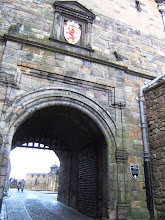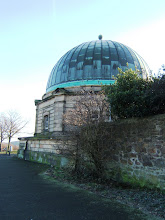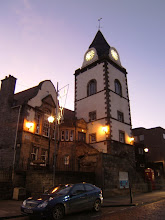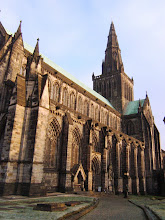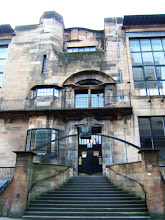 Full Scottish breakfast is included with my room rate £35 per night and so I enjoy eggs, mushrooms, tomatoes and toast before heading out sight-seeing.
Full Scottish breakfast is included with my room rate £35 per night and so I enjoy eggs, mushrooms, tomatoes and toast before heading out sight-seeing.At Buchanan Bus Terminal I stop in to get the time-table for the Glasgow Flyer which I’ll take back to the airport early tomorrow morning.
It’s frosty cold, -7C, as I make the 40 minute walk to Glasgow Cathedral. Built in the 13th and 14th centuries, it is massive and wonderfully low-key. No gift shop; admission by donation. No one wants to sell you a photography permit for £2 like they do at St Giles in Edinburgh. It’s eerily quiet as I view the various chapels and marvel at the workmanship throughout.
Also in Cathedral Square is St Mungo Museum of Religious Life and Art. I was not expecting such engaging displays about how life events – birth, coming of age, marriage and death – are marked by various world religions. The artifacts and multimedia components are very interesting. I learn that Christianity was first brought to Glasgow by St Mungo (aka St Kentigern) over 1400 years ago.
 Across the street is Provand’s Lordship, the oldest house in Glasgow. It was built in the 1471 as the manse for St Nicholas Hospital. It has at various times in its history been a private residence a sweet shop and was saved from demolition by the Provand’s Lordship Society. The knot parterre, based on a Celtic design is at the centre of a medicinal garden that was opened in 1995 [picture left ].
Across the street is Provand’s Lordship, the oldest house in Glasgow. It was built in the 1471 as the manse for St Nicholas Hospital. It has at various times in its history been a private residence a sweet shop and was saved from demolition by the Provand’s Lordship Society. The knot parterre, based on a Celtic design is at the centre of a medicinal garden that was opened in 1995 [picture left ].I walk for about 30 minutes to St Enoch subway station and get a £1.10 ticket to travel three
 stops to Shields Street on the “Outer Line”. The Glasgow subway system , opened in 1896, is made up of dual tunnels that form a basically oval route. The Outer Line runs in a clockwise direction and the Inner Line goes counter-clockwise.
stops to Shields Street on the “Outer Line”. The Glasgow subway system , opened in 1896, is made up of dual tunnels that form a basically oval route. The Outer Line runs in a clockwise direction and the Inner Line goes counter-clockwise.The Scotland Street School is across the road from the Shields Street station. Designed by Charles Rennie Macintosh, the school opened in the summer of 1906 and was designed to accommodate 1250 pupils. The area, known as Kingston, served a growing population employed by the extensive shipbuilding industry and engineering works around the River Clyde. After the Second World War, Kingston changed dramatically
 when local industry declined, residents were relocated to towns outside Glasgow and their tenements demolished. The school had only 89 remaining pupils when it closed in 1979. Classrooms are restored to various eras: the 50s and 60s, World War II and Victorian. There are good exhibits about Mackintosh's designs, the conflicts he had with the School Board over them and the compromises that were made.
when local industry declined, residents were relocated to towns outside Glasgow and their tenements demolished. The school had only 89 remaining pupils when it closed in 1979. Classrooms are restored to various eras: the 50s and 60s, World War II and Victorian. There are good exhibits about Mackintosh's designs, the conflicts he had with the School Board over them and the compromises that were made.Back on the subway, I take the “Inner Line” five stops to Cowcaddens Station and it’s only a 10 minute walk back to my hotel.























